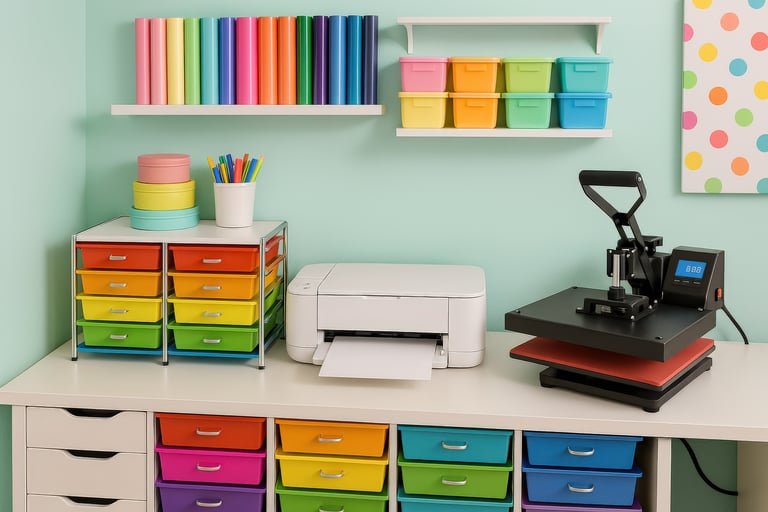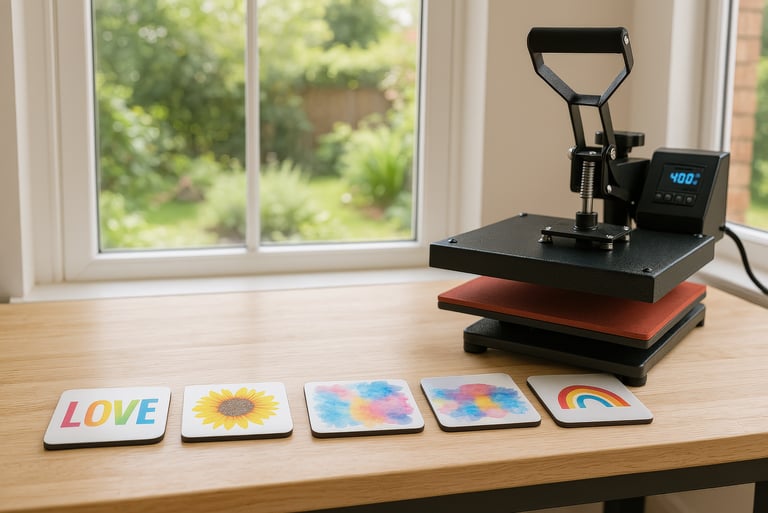How to Start Sublimation Printing: A Complete Beginner’s Guide
Sublimation printing is one of the most exciting ways to bring your designs to life on items like mugs, t-shirts, coasters, and more. If you’re just getting started, the good news is—you don’t need a professional print shop to create high-quality, long-lasting prints right from home. This guide will walk you through everything you need to know to begin your sublimation journey—from understanding how it works to completing your first print. Whether you're crafting for fun, gifts, or even a small business, this beginner-friendly overview will help you start strong and avoid common pitfalls.
SUBLIMATIONBEGINNER'S GUIDES
Melissa AF Harmon
6/5/20253 min read
What Is Sublimation Printing?
Sublimation printing is a digital printing technique that uses heat to transfer dye onto specially coated materials like polyester fabrics, ceramics, and aluminum. The term “sublimation” refers to the scientific process where a solid turns into a gas without going through a liquid phase. In printing, this means the solid dye on your transfer paper turns into gas when heated and embeds itself directly into the surface of your blank item.
This process results in vibrant, permanent, and fade-resistant prints that won’t peel or crack over time. Unlike vinyl or screen printing, sublimation actually dyes the material itself—making it ideal for creating long-lasting, full-color images.


Before jumping into your first project, you’ll need to gather a few essential items. Here’s a quick breakdown of the basic equipment and supplies every beginner should have to start sublimation printing:
Sublimation Printer: Use either a dedicated sublimation printer or a converted inkjet model like the Epson EcoTank.
Sublimation Ink: Special dye-based ink that turns into gas under heat and embeds into your blank material.
Sublimation Paper: Designed to hold and release sublimation ink during the heat transfer process.
Heat Press Machine: Applies heat and pressure. Comes in various types for flat items, mugs, and tumblers.
Sublimation Blanks: Items with a polyester coating or high polyester content (shirts, mugs, etc.).
Design Software: Canva, Photoshop, or Silhouette Studio are great tools to create or modify your designs.
What You Need to Get Started
Setting Up Your Workspace
Having a well-organized, safe workspace makes sublimation more enjoyable and productive. Here’s how to set it up:
Choose a clean, flat surface with access to power outlets and good ventilation.
Use heat-resistant mats or tables to protect your work area from high temperatures.
Store supplies like ink, blanks, and paper in labeled containers away from sunlight or moisture.
Wear heat-resistant gloves when handling freshly pressed items, and keep flammable objects clear of your press.


Designing Your First Project
Design is where your creativity shines! Here’s how to get started with your first design:
Use beginner-friendly tools like Canva or Silhouette Studio.
Choose simple, high-resolution graphics—especially for your first few projects.
Mirror your design before printing (especially important for text).
Print a test page on regular paper to confirm layout and color accuracy.
Set your printer to high-quality/photo print mode for sharp, vibrant results.
Now comes the fun part—bringing your design to life!
Preheat your press to the recommended temp (usually 385–400°F).
Prep your blank by cleaning and lint-rolling to remove debris.
Position your design (ink side down) and tape it securely using heat-resistant tape.
Press your item for the suggested time (check settings by material).
Remove and let cool before handling. Some items are “warm peel,” others are “cold peel.”
The Heat Press Process
Faded colors? Check heat/time/pressure settings.
Ghosting? The paper might have shifted—use more tape.
Uneven transfer? Ensure your press applies even pressure across the surface.
Troubleshooting:
Start with small projects like coasters or keychains.
Log your settings for each material to avoid repeating mistakes.
Always double-check that your design is mirrored before printing.
Give yourself plenty of workspace and keep it clutter-free.
Join sublimation groups or forums to learn from others.
Most importantly—embrace mistakes as part of the learning process.
Tips for Success as a Beginner


With the right tools, workspace setup, and a little patience, you’ll be creating colorful, custom items in no time. Use this guide as your roadmap, and don’t be afraid to explore, experiment, and most importantly—enjoy the process.
Melissa AF Harmon Creative, LLC
Simplifying systems for creative entrepreneurs and educators.
© 2025. All rights reserved.
